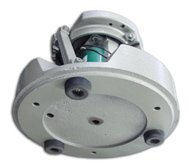Parts Feeding Tip: Isolating Vibration Enhances Feeder Performance
Vibratory Parts Feeders are often affected by the transfer of vibration to a weak support system. When possible, the feeder stand should be made more rigid or reinforced. However, this is often difficult due to the inability to shut down a production line. In cases such as this, here are some techniques that can be attempted to better isolate the vibration and enhance feeder performance:
Drive Units
Check the condition of the rubber feet
Based on our experience, this is leading cause of poor feeder performance.
As rubber ages, it begins to harden and crack and vibration sometimes accelerates the process (called "Curing"). A hardened foot will transfer too much of the vibration to the stand. If the rubber feet are hard or are worn to the point that the bolts on the bottom are resting on the table, they
We offer two types of rubber feet for vibratory feeders hard and soft. The hard are chosen for durability. The soft feet greatly enhance
Here is the rubber feet selection chart.
If you would like to read more on rubber feet, here is a past tip on rubber feet
Hoppers
The same principles apply to vibratory hoppers. To optimize performance, the goal should be to isolate the vibration.
The first step to ensuring proper performance is to ensure the stand or table the vibratory hopper is bolted to is rigid.
These two techniques are the most common ways to isolate the vibration from hoppers:
- Add rubber feet to the base of the hopper between the hopper and the base plate/table.
- Place a rubber mat between the hopper and the base plate/table
Vibratory Track Feeders
Vibratory inline feeders, also known as track feeders, should be mounted directly to a rigid surface. They do not require rubber insulating feet or a rubber pad.
For more information, visit Inline Feeders

